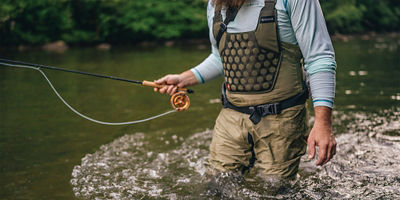
You can haul it in tackle boxes, but if you have a long walk or are planning to move quickly from one spot to another, a fishing vest can be a better option. While vests have long been favored for fly fishing, their utility, versatility, and comfort make them great for bait casters as well. Here’s how to find the right fishing vest for you.
Questions to Ask Yourself
Before you buy a vest, figure out where and how you like to fish.
What kind of fishing am I doing?
Are you just going out for a quick cast, or are you headed to the river for an epic fly-fishing trip with every lure you own? Knowing how you’ll fish will inform how you need to carry your gear.
What time of year will I fish?
In hot weather, opt for a vest made from mesh and lightweight materials. If you’ll fish in cooler weather, make sure your vest is roomy enough to allow you to wear warmer layers underneath.
How much stuff do I have?
Buy a vest that can accommodate everything you need to bring but won’t leave a bunch of empty pockets left over (you’ll just be tempted to overpack).
Material
A vest’s build has a big influence on its overall performance.
Mesh
A mesh vest breathes well and offers good flexibility. It’s great for hot days, but when the temperatures dip, you can also add more layers underneath for warmth (as long as you get a size big enough). On the downside, mesh isn’t as durable as other materials, and it snags easily on branches or hook barbs.
Polyester and Nylon
For a more solid construction, look for abrasion-resistant materials like polyester or ripstop nylon. These durable fabrics will keep your vest from tearing and help it last longer; they’re also lightweight and breathable.
Cotton
Cotton and canvas are classic fabric choices for fishing vests, but they weigh more than newer materials, will be warmer on hot days, and won’t dry quickly if they get wet.



















